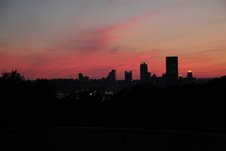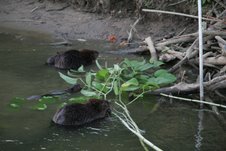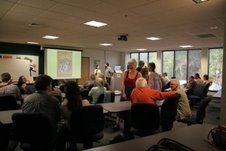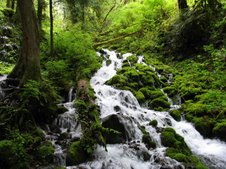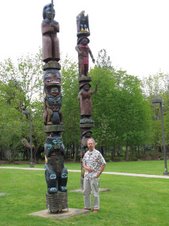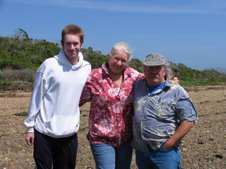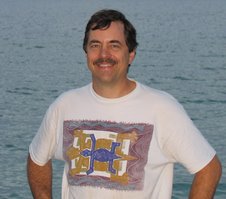From Port Townsend, I drove down to Portland to visit with Susi Stahl Palmrose, who was on the United States and European walks. She grew up on an intentional community in Virginia and attended a Quaker high school. She was eighteen years old during the first walk; she turned nineteen on the last day in Washington D.C.. Now, she has three children and a husband. "One time on the walk in the Midwest," she recalled, "I was walking in the rain and it was kind of chilly. On the outside it would look kind of miserable. I saw pity on people's faces when they glanced my way as they were whizzing by in their metal boxes. But I was very happy and very content. I felt there was nothing else I'd rather be doing, a very peaceful feeling. I was right with the world."
"I joined the walk right out of high school so it was my way of stepping out into the world on my own. Everything was sharp and bright and interesting and new. I remember walking in California, I wanted to capture every sight and tell my family about it. And the experience of just walking is a way of being very real, down to the basics and very simple. You're right there on the road or in the mountains and you got there on your own two feet; that was an internal thing for me. I felt like I was not only doing something for my own benefit, but also setting a good example and a good expression for the rest of the world.
"I know now that those experiences that I was having are important to me for the rest of my life because now when I just take a short walk any where, it's almost like I can just tap into my old walker self. So it's more meaningful for me to just take a little walk. The walk formed something of who I am. Now, in my life I like to bike a lot, so I've transferred some of that to the bike. It can become a tiny revolutionary act of sanity in an insane world because you're slowing things down to a pace that's more natural. I think that our pace of life is unnatural and hasn't given anybody a better lifestyle. I like some things about technology, but a lot of it has made our lives more stressful. Just because we have more machines doing our work doesn't necessarily make us happy or give us more time to relax."
After the walks, Susi began to raise a family. She went back to school when her youngest son was old enough to attend kindergarten. "I wanted to help people in some way," she said. "Nursing was a good fit once I learned the philosophy of nursing. I try to help people where they're at and I'm trying to be non-judgemental and compassionate, even when people have destroyed themselves by their own lifestyle choices such as drugs, drinking, smoking and obesity. Those can be the symptoms of the unhealthiness of the earth; the opposite of what the walk stood for. The medical world is almost enabling the unhealthy lifestyle to continue by allowing people to live half sick by simply prescribing medicine or doing medical procedures, but I'm in the medical world. That's the conflict that I'm trying to work out. The challenge is to be unconditionally loving while knowing that people are accountable for their choices. It's not up to me to give them their lessons. It's up to them and God. But I do encourage them to make healthy choices." Susi tries to set a healthy example by riding her bicycle to work.
In raising her children, Susi tries to set a good example. "Angela (oldest child) has said that I'm more peaceful and relaxed than anyone she knows, so I was glad that I'm that way and she sees that. I've raised my children to be concerned about other living things; I think any living thing is just as important as humans. It's all part of the natural balance of things. I've tried to teach my kids that, but it's up to them to decide for themselves and figure out their own ways."
Tomorrow, we plan to do some hiking and we're doing a program for friends in the evening in her living room. Some friends who do not have vehicles plan to take the light rail system to a station that is only a short distance from Susi's house.
Thursday, May 3, 2007
Other Walks
Jean, a neighbor of David and Casey Gluckman--my hosts in Port Townsend--came over yesterday evening with books and a video about the Great Peace March of 1986. She was a thru-walker in the nine-month trek from California to Washington D.C. Our discussion the night before had stimulated renewed interest and memories.
The Great Peace March began with a central organizing group, a large budget, and well over a thousand marchers. Overhead was extremely high, however, and logistics for taking care of that many marchers were a nightmare. The central organizing group went bust in less than three weeks, leaving the walkers stranded in the Mohave Desert. But the human spirit can be strong, and much to the surprise of the media and others, most of the walkers reorganized and persevered; they ultimately completed the walk with much fanfare in Washington. The video was well done and inspirational, and afterwards, Jean exclaimed, "It's time to do another walk!"
In that vein, in San Francisco I had learned of another cross country walk being planned. Native American activist Dennis Banks is spearheading the coast to coast trek to begin next spring on the 30-year anniversary of the Native Americans' "Longest Walk." This one will be called the Longest Walk II. The main message of the walk: all life is sacred. To learn more, log onto http://www.longestwalk.org/.
The Great Peace March began with a central organizing group, a large budget, and well over a thousand marchers. Overhead was extremely high, however, and logistics for taking care of that many marchers were a nightmare. The central organizing group went bust in less than three weeks, leaving the walkers stranded in the Mohave Desert. But the human spirit can be strong, and much to the surprise of the media and others, most of the walkers reorganized and persevered; they ultimately completed the walk with much fanfare in Washington. The video was well done and inspirational, and afterwards, Jean exclaimed, "It's time to do another walk!"
In that vein, in San Francisco I had learned of another cross country walk being planned. Native American activist Dennis Banks is spearheading the coast to coast trek to begin next spring on the 30-year anniversary of the Native Americans' "Longest Walk." This one will be called the Longest Walk II. The main message of the walk: all life is sacred. To learn more, log onto http://www.longestwalk.org/.
Wednesday, May 2, 2007
WaHeLut Indian School
I spoke to John's class at the WaHeLut Indian school on Monday. The school was named for a Nisqually warrior and medicine man who resisted white settlement and whose power is said to have flowed from thunder and lightning. John's nine fifth graders were friendly, lively and interested in the walks. Afterwards, the class took outside to their school sweat lodge along the Nisqually River. One girl said she had participated in a sweat ceremony the day before. Another student said he received his Indian name in a sweat ceremony. All of them had participated in a sweat ceremony at one time or another and they knew the main purposes of the ceremony--the purification of mind, body and spirit.
The school itself was immaculate, with totem poles adorning the front entrance and life-sized carvings of what was described as welcoming figures in the main entranceway. A large mural and dugout canoe depicted traditional life along the river. I met the principal and assistant principal and felt very welcome.
That evening, I joined John and his wife Susan in watching eight-year-old Keats Montrose play in a baseball game in the cold drizzle. I was convinced that the game would have been cancelled in normally drier climates. Just after Keats made a clutch hit with bases loaded, the game was stopped when the rain intensified and players were visibly shivering, along with spectators such as the one from Florida.
Now, I am staying with friends in Port Townsend, Washington. We had a neighborhood gathering last night, discussing the walks and other subjects. Overall, Port Townsend is an environmentally friendly community with a large group of people working to reduce their energy useage and "carbon footprint" in an effort to check the advance of global warming. Today, we hope to do some kayaking in Puget Sound.
The school itself was immaculate, with totem poles adorning the front entrance and life-sized carvings of what was described as welcoming figures in the main entranceway. A large mural and dugout canoe depicted traditional life along the river. I met the principal and assistant principal and felt very welcome.
That evening, I joined John and his wife Susan in watching eight-year-old Keats Montrose play in a baseball game in the cold drizzle. I was convinced that the game would have been cancelled in normally drier climates. Just after Keats made a clutch hit with bases loaded, the game was stopped when the rain intensified and players were visibly shivering, along with spectators such as the one from Florida.
Now, I am staying with friends in Port Townsend, Washington. We had a neighborhood gathering last night, discussing the walks and other subjects. Overall, Port Townsend is an environmentally friendly community with a large group of people working to reduce their energy useage and "carbon footprint" in an effort to check the advance of global warming. Today, we hope to do some kayaking in Puget Sound.
Subscribe to:
Posts (Atom)

